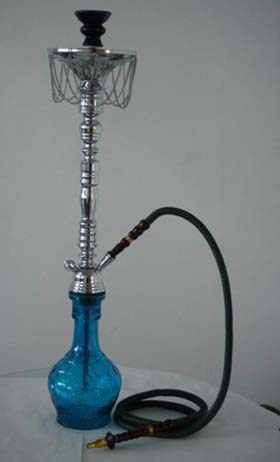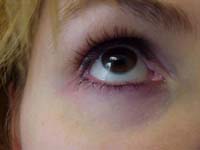MedPage(12/17, Bankhead) reported that "breast cancer patients may unknowingly expose themselves to estrogen by using certain skin moisturizers," according to a researcher at the San Antonio Breast Cancer Symposium. Adrienne C. Olson, Pharm.D., of Breastlink in Rancho Palos Verdes, "collected containers of 16 nonprescription skin moisturizers, spanning a wide cost range." Dr. Olson "sent the samples to a research laboratory, which tested the products for the presence of estradiol, estrone, and estriol." According to Dr. Olson, "laboratory analyses identified a half-dozen different products containing measurable levels of estriol and estrone," even though "none of the products listed the estrogenic hormones among its ingredients."
IRANDERMA |
|
Medical News |
In a trial among 22 people with severe pemphigus, a disorder marked by blisters on the skin and in the mouth and genitals, 59 percent were symptom-free more than six years after treatment with a single dose of Rituxan, researchers at France’s National Institute of Health and Medical Research in Rouen wrote in the journal Science Translational Medicine.
Pemphigus is usually treated with steroids, though relapses are common, requiring long-term treatment that can cause complications including diabetes, osteoporosis and severe infections. While the study tested Rituxan in patients already treated with steroids, the researchers expect results in about a year from a larger trial that compares the drug with steroids as a frontline therapy, said Philippe Musette, a professor of dermatology who led the research.
“In an autoimmune disease it’s really difficult to have complete remission,” Musette said in a telephone interview. “With one shot of rituximab we have a long-term result,” he said, using Rituxan’s generic name.
Source: Bloomberg
The Washington Times (1/9, Wetzstein) reports that the Centers for Disease Control and Prevention Sexually Transmitted Disease Surveillance 2012 report (pdf) released yesterday shows that gonorrhea rates increased in 2012 and syphilis rose 11%, while chlamydia remained relatively flat, although a record 1.4 million cases existed. The report states, “This is the largest number of cases ever reported to the CDC for any condition,” with the National Coalition of STD Directors adding that “rising STD rates have a major negative impact on our ability to address the HIV epidemic.” Public health officials are encouraging sexually active individuals to undergo annual STD screenings, with men who have sex with men (MSM) screened at shorter intervals if partners are not monogamous or use illicit drugs.
Bloomberg News (1/9, Lopatto) reports that the CDC connected this rise in STD infection rates to “inadequate testing among people stymied by homophobia and limited access to health care.” According to CDC STD Prevention Division Director Gail Bolan, “We know that having access to high-quality health care is important to controlling and reducing STDs. Some of our more-vulnerable populations don’t have access. There are a number of men who come in to our clinic for confidential services because they’re too embarrassed to see their primary care doctors.”
The Huffington Post (1/9) quotes the report as recommending “dual therapy with ceftriaxone and either azithromycin or doxycycline” for gonorrhea treatment.
Psoriasis phototherapy increases vitamin D, too
In patients with psoriasis,
narrow-band ultraviolet-B light increased serum vitamin D levels
while clearing the condition, researchers said.
In a prospective cohort study in Ireland, after treating "30
consecutive patients...with narrow-band ultraviolet-B -- in
wavelengths of 311 to 313 nanometers -- three times a week until
their condition cleared," researchers found that the "median level
of serum 25-hydroxyvitamin D [25(OH)D] had more than doubled at the
end of successful phototherapy, compared with no change among
untreated controls."
.....Because the lack of association with response -- those who needed more exposures to clear their condition had significantly higher serum 25(OH)D levels at the end of treatment -- "we cannot conclude, therefore, that narrowband UV-B mediates its therapeutic effects by increasing vitamin D levels," the researchers wrote.
Nonetheless, the study "provides further insight into the role of vitamin D specific to patients with psoriasis," argued Pranita Vemulapalli, BS, and Henry Lim, MD, both of the Henry Ford Medical Center in Detroit.
In an accompanying editorial, they said that although the study could not establish a causal link, "it did highlight the prevalence of hypovitaminosis D in the population of patients with psoriasis in northern latitudes."
SOURCE: Archives of Dermatology: 2010;146
Skin changes in postmenopausal women unaffected by hormone therapy
05 September 2008
SOURCE: J Am Acad Dermatol 2008; 59:397-404
Age-related facial skin changes in postmenopausal women are unaffected by long-term hormone therapy, according to findings published in the Journal of the American Academy of Dermatology.
Declining estrogen levels are associated with a variety of skin changes in postmenopausal women, such as decreased skin thickness, collagen content and elasticity, increased fine wrinkling and dryness, and impaired wound healing. Many of these changes are reportedly reversed or improved by estrogen supplementation.
Phillips and team evaluated the effects of continuous combined norethindrone acetate (NA) and ethinyl estradiol (EE) in the control of mild-to-moderate age-related skin changes in 485 women who were, on average, 5 years postmenopausal. The women were randomly assigned to receive double-blind treatment with placebo, 1 mg NA/5 µg EE, or 1 mg NA/10 µg EE, for 48 weeks.
At week 48, there were no significant differences between placebo and the hormone therapy groups with regard to the primary endpoints: investigator global assessment of coarse and fine facial wrinkling, and patient self-assessment of changes in wrinkling. Instead, slight decreases for both endpoints were observed in all three treatment groups.
There were also no significant differences among the three treatment groups for the secondary endpoints. Secondary endpoints included investigator global assessment and patient self-assessment of skin laxity/sagging and texture/dryness, as well as wrinkle depth and skin elasticity.
"It is possible that longer treatment duration, or different formulations or doses of estrogen, might have more positive effects," comment Phillips and team. "Differing progestogen combinations and examination of nonphotodamaged skin might also demonstrate different outcomes."
Phillips and colleagues note that a marginally significant overall treatment effect was observed in the subgroup of women who were less than 24 months postmenopausal (n=57).
Despite the result being unreliable due to the small sample size, and the fact that the current study was not designed to look at women who were in the early postmenopausal period, the researchers say that "future studies in this group would be of interest, particularly as hormone therapy given close to menopause appears to be safest."
Breast cancer and skin moisturizers!
The combination of higher altitude and ultraviolet (UV) rays reflected by the snow puts skiers and snowboarders at an increased risk of sun damage and ultimately, skin cancer.
While it "is easy to associate winter with frostbite and windburn... most people are unaware that UV rays can be even more damaging on the slopes than on the beach." That's because "UV exposure increases eight to10 percent with every 1,000 feet above sea level." In addition, "snow reflects about 80 percent of the UV light from the sun, meaning that you are often hit by the same rays twice." Winter sports enthusiasts should "use a broad-spectrum sunscreen with an SPF of 15 or higher," and "apply it 30 minutes before hitting the slopes," even on cloudy days, and wear a "lip balm with an SPF 15 or higher."
Stress may trigger bad habits which increase heart attack risk
HealthDay (12/15, Edelson) reported, "Stress increases the risk of heart attack and other cardiovascular problems by pushing people toward bad habits," according to a study published in the Dec. 16/23 issue of the Journal of the American College of Cardiology. Mark Hamer, Ph.D., of University College London, and colleagues, "followed 6,576 participants in the Scottish Health Study, which started with them filling out a 12-item questionnaire designed to measure their general happiness by listing such things as symptoms of depression or anxiety and recent sleep disturbances. About 15 percent of the people in the study were classified as suffering from psychosocial stress on the basis of their answers." The investigators "also collected physical data, starting with basic information on weight, height, physical activity, alcohol intake, smoking, and blood levels of cholesterol and C-reactive protein (CRP)."
Participants "were followed for an average of seven years, and during this time there were 223 incident cardiovascular disease events, including 63 fatal events," Medscape (12/15, O'Riordan) added. "In an age- and sex-adjusted model, individuals identified as psychologically distressed on the GHQ-12 [General Health Questionnaire] had a 54 percent increased risk of cardiovascular events during the follow-up period, confirming existing data." Overall, the authors demonstrated that "behavioral factors, including smoking, physical activity, and alcohol consumption, accounted for 65 percent of the relationship between psychological distress and cardiovascular disease risk." Notably, another "19 percent of the association was explained by pathophysiological risk factors, such as hypertension" and CRP.
Asthma Drug May Help Those With Chronic Hives
July 21, 2014
A drug already used to treat moderate-to-severe allergic asthma (Omalizumab=Xolair) appears to offer relief to people with chronic hives who haven't been helped by standard medications, new research suggests.
The current study confirms that when Xolair is taken at a high dose for a six-month period it seems to be both safe and effective at controlling the severe and often debilitating itching that characterizes long-term hives.
....While not lethal, chronic hives can last for months, and tend to come and go without a clear idea of what brings it on...
To explore Xolair's potential, the team tested its effectiveness among more than 260 chronic hives patients for whom prior treatment had failed.
Patients were randomly divided into four groups, in which they were respectively treated with a once-a-month injection of Xolair at either a 75 milligram (mg) dose, a 150 mg dose, a 300 mg dose, or a dummy shot.
Tracking was conducted for both a three-month period and a six-month period.
The team found that by the 12th week, people given Xolair showed a marked reduction in their overall number of hives, hive intensity and itching severity, compared with patients who got the dummy treatment. Symptom relief was maintained through the six-month mark, and the authors determined that those treated with the highest (300 mg) dosage of Xolair saw the biggest improvement.
Side effects were described as being mild to moderate, and included headaches, joint pain, sinus infection and reactions at the point of injection.
The study authors acknowledged that more research will be needed to see how the drug performs over longer periods of time.
Dr. Robert Kirsner, chair of the department of dermatology and cutaneous surgery and chief of dermatology at the University of Miami Miller School of Medicine, suggested that the new intervention could prove to be a boon for a condition that "can significantly affect patients' quality of life."
SOURCE: The Journal of Investigative Dermatology
Don't blow your nose when you have a cold!
Blowing your nose to alleviate stuffiness may be second nature, but some people argue it does no good, reversing the flow of mucus into the sinuses and slowing the drainage.
Counterintuitive, perhaps, but research shows it to be true.
To test the notion, Dr. J. Owen Hendley and other pediatric infectious disease researchers at the University of Virginia conducted CT scans and other measurements as subjects coughed, sneezed and blew their noses. In some cases, the subjects had an opaque dye dripped into their rear nasal cavities.
Coughing and sneezing generated little if any pressure in the nasal cavities. But nose blowing generated enormous pressure — “equivalent to a person’s diastolic blood pressure reading,” Dr. Hendley said — and propelled mucus into the sinuses every time. Dr. Hendley said it was unclear whether this was harmful, but added that during sickness it could shoot viruses or bacteria into the sinuses, and possibly cause further infection.
The proper method is to blow one nostril at a time and to take decongestants, said Dr. Anil Kumar Lalwani, chairman of the department of otolaryngology at the New York University Langone Medical Center. This prevents a buildup of excess pressure.
Source: New York Times
Stress and Psoriasis
Patients with psoriasis who have
persistently high levels of daily stressors have decreased cortisol
levels, making them particularly vulnerable to peak stress times that
are related to subsequent worsening of the disease, report researchers.
"Clinicians should be aware of the possible effect of daily stressors on disease outcome and endocrine function, particularly when patients are going through stressful periods and for those subgroups of patients who are most vulnerable to the enduring influence of daily stressors," say Andrea Evers and colleagues from the Radboud University Nijmegen Medical Centre in The Netherlands.
Experimentally induced stress has been shown to blunt hypothalamic-pituitary-adrenal (HPA) axis activity in psoriasis patients, the researchers explain in the British Journal of Dermatology, which may result in increased inflammatory responses due to the diminished suppressive effect of cortisol.
Evers and colleagues have previously shown that increased peak levels of daily real-life stressors are associated with decreased cortisol levels, and increased psoriasis disease severity a month later.
In this study, the team studied serum cortisol levels, clinical indicators of psoriasis disease severity, and self-report measures of daily stressors (such as running late for an appointment or losing keys) over 6 months in 62 patients with psoriasis, aged an average of 52 years.
They found that patients who consistently experienced high enduring levels of daily stressors, as indicated by above-median total daily stressors levels, had lower average levels of cortisol than those with below-median total daily stressors levels, at 0.29 vs 0.37 µmol/l.
There was no difference in current disease severity between patients with high total daily stressors levels and those with lower levels, at a Psoriasis Area and Severity Index of 7.34 versus 5.84, respectively. And, while levels of daily stressors correlated negatively with cortisol levels, no correlation was seen between daily stressors and disease severity.
But based on their previous findings, the researchers say the decreased cortisol levels associated with high daily stressors levels "might reflect a general vulnerability to exacerbation of inflammation in these patients, such that relatively stressful periods may aggravate the course of psoriasis in these individuals in particular."
MedWire (9/18, Piper) reported that, according to a study published in the Sept. issue of the journal Acta Dermato-Venereologica, "excessive body weight increases both the risk for psoriasis onset and the severity of the condition." Researchers from Sweden's Karolinska Institute "performed a population based case-control study involving 373 patients aged between 17 and 84 years who had developed plaque psoriasis for the first time within the past 12 months," matching "these patients...to 373 individuals without psoriasis." The team found that "obese individuals were twice as likely as normal weight individuals to develop psoriasis." Furthermore, "each one-unit increment in" body mass index (BMI) "was associated with a seven percent higher relative risk for increased psoriasis activity, while a five-BMI-unit increase increased the risk by 38 percent."
Cancer cells grow weaker under simulated spaceflight conditions, suggests German researchers.
In the journal Acta Astronautica,
a team led by Krassimira Ivanova of the German Aerospace Center in Cologne,
looks at melanoma cells -- the most dangerous form of skin cancer.
In comparison to cancer cells grown under normal gravity, batches of them rotated to simulate weightlessness for six hours and 24 hours, show they release significantly lower levels of cancer gene chemicals tied to the "metastatic" spread of skin, lung and ovarian cancer throughout the body.
"This is an interesting rapid publication that suggests that the growth of some cancer types might be different in space," says the Rupert Gerzer, the journal's editor-in-chief, in a commentary. "The data within the paper is of high scientific interest and is also operationally important, as cancers like the malignant melanoma described in this paper may lie dormant for decades but may be activated when the immune system is compromised, e.g., during a spaceflight."
The authors caution the results need to be tested in more than just test tubes, however, concluding, "whether simulated weightlessness and/or real microgravity may alter the metastatic potential of melanoma cells remains to be investigated."
Source: USA today
Shisha; more dangerous than cigarette
June 01, 2008
A new study finds that the use of water pipes may be on the rise among college students. Some believe that smoking tobacco this way is less dangerous than smoking cigarettes —which is not the case, the researchers say.
The study, which appears in the May issue of The Journal of Adolescent Health, looked at water-pipe use among students at Virginia Commonwealth University. It found that of more than 700 students surveyed, more than 40 percent reported having used a water pipe in the previous year.
The pipes, often called hookahs or shishas, are perhaps best known in the Middle East and are used to smoke flavored and sweetened tobacco. The tobacco is heated over charcoal, and then is cooled as it passes through a bowl of water and is inhaled from a hose.
Despite the belief of some
students, water pipes may expose users to more toxic materials than
cigarettes. Each puff has as much as 100 times the smoke as a puff from
a cigarette, the study said. And smokers are also inhaling fumes from
the charcoal.
June 2008
A robot that
can pluck and move individual hair follicles on a person's head makes
hair transplants look more natural than those performed by humans, a US
company claims. 
The robot can also perform the procedure twice as fast as human clinicians, with less pain and scarring for the patient, says Restoration Robotics of Mountain View, California.
Standard hair transplants typically take 8 to 10 hours. A strip of healthy, hairy scalp 1 centimetre wide and 15 cm long is removed from the back of the head under local anaesthetic.
After the gap is sewn up, medical staff then manually separate the strip into 2000 individual hair follicle "bulbs". These are painstakingly implanted in 1-millimetre wide incisions across bald parts of the head.
"It's a lot like gardening," says Rogers. "Removing the strip is like pulling turf and implantation is like planting bulbs."
But Frederic Moll of Restoration Robotics says the expensive (from around £3000, or $5800), time consuming and repetitive task needs automating.
Instead of removing a strip of scalp, which is painful and carries the risk of infection, his robot plucks healthy follicles individually, at a rate up to 1000 an hour...
...The robot has another advantage over manual transplants – the ability to design somebody's hairline on a computer. This can help give the transplanted hair a more natural look...

“Dark circles around the eyes can be unsightly,” declares one advertisement for an eye cream. An advertisement for Hylexin cream features a pale model with black stripes under her eyes, like a football player, for dramatic effect. And just in case you think you are overreacting, the ad reinforces the notion that dark circles are indeed a flagrant shortcoming.
Roughly 53 percent of the 13,000 Clinique users surveyed by the company in 2006 cited under-eye circles and puffiness as their No. 1 beauty concern.
“We were really shocked,” said Dr. Mammone, who has a Ph.D in molecular and cellular biology. “We knew many of our people in distribution and sales suggested that it was a concern, but we didn’t really know until the survey that it is a major issue.”
Sales of anti-aging skin care treatments, which include products designed to get rid of dark circles, increased to $1.08 billion in 2006, up from $588 million annually in 2001, according to Mintel, a market research firm. No one specifically tracks the market for dark-circle remedies.
Taming dark circles is tricky.
There are a lot of factors that contribute to quote-unquote dark circles.
Most people think dark circles are a telltale sign of tiredness, or the unsightly evidence of a binge involving one too many margaritas. That is true to a certain extent, as fatigue makes skin dull, and drinking alcohol dehydrates and thins the skin.
But the most likely culprit causing chronic dark circles, dermatologists say, is excess pigmentation in the skin. Dark circles are prevalent on all skin colors and types, but they especially trouble African-Americans, Southeast Asians and Southern Italians. Beach bunnies should note: sun exposure exacerbates dark circles.
Dilated blood vessels that sit close to the thin under-eye skin are another cause, doctors said.
Aging, which causes skin to thin, can darken the eye area, as can certain medications such as birth control pills, which can dilate blood vessels.
The problem is that few, if any, of the creams on the market are formulated for people with excess pigmentation or dilated veins.
Multiple creams are available, however it is unclear how effective they are!
Source:![]()
OTC Scar Repair Products Rarely Effective.
Indeed, many of the elixirs on the market sounds a bit like folk medicine, promising to reduce the appearance of scars with onion extracts or vitamin oils. They're not cheap either, the L.A. Times reports, especially since you have to use them long-term; scars take six months to two years to heal.
The only thing really shown to help the healing process and minimize scarring, [Dr. Joseph Sobanko, a dermatological surgeon at the University of Pennsylvania Health System] says, is keeping a wound moist and covered. Most scar products do that. But there's little evidence that they work any better than inexpensive petroleum jelly.
Studies of products like Mederma, which uses onion extract, and vitamin E oils found that they worked no better than cheaper Vaseline (presumably, other cheap oils like coconut or olive would work similarly too), while data on antibiotic ointments found that they didn't help healing or reduce infection. Plus, antibacterial products contribute to the rise of antibiotic resistance.
The only product that appeared to have any clinical benefit was silicone gel sheets, the kind that have been used on burn victims since the 1980s. Studies suggest that the sheets help prevent new scars and soften old ones.
Silicone gel sheeting seems to be the exception. Several articles reviewing 30 years of research suggest that it can speed healing and lead to thinner, softer, less red and less painful scars, depending on the study. It's not clear what silicone itself does. But the sheets do a better job of keeping the scar covered, and that prevents water from evaporating from the skin.
Moisture is key because it lets the skin grow back evenly, says Dr. [Jessica] Wu, a Los Angeles dermatologist. "If you slice a finger open as you're cutting your bagel in the morning, you have two edges of the wound. The new skin grows across that gap," she explains. "If the wound dries, a scab forms between the two edges. Now the skin has to grow down and across, like it encountered a boulder. It's likely to lead to a depressed, pitted scar."
SOURCE: LA Times
ايران درما |

